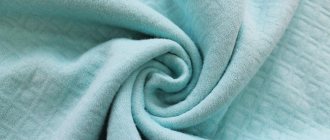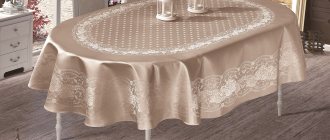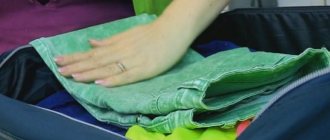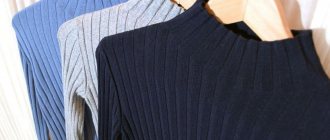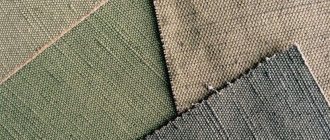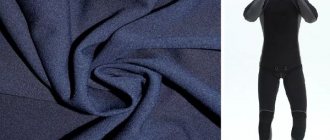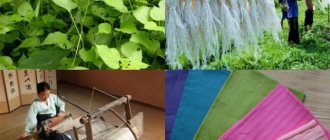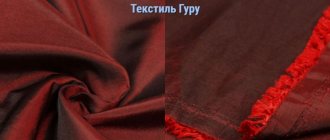The chemical industry is developing every day, so humanity receives various unique materials for its life. They are used to make products for various purposes. PVC is quite unique in terms of application and physical characteristics. It is especially worth highlighting from the line of products made from polyvinyl chloride - PVC fabric, which is a composite and predominantly two-layer fabric.
This fabric uses a durable mesh of Dacron, nylon or nylon thread as a base, which is coated with PVC and elastic plasticizers (mainly vinyl polymers). Thanks to this, the fabric becomes durable and very strong. The material is often used to make boats for recreation and fishing, awnings, advertising products, etc.
Large selection of colors
Methods for making PVC fabric or PVC awning
The main methods for producing PVC fabric are lamination and casting. In the first case, a PVC film is applied to the prepared base (a mesh of polyester, nylon or lavsan). This method is considered simple, inexpensive and less labor-intensive, so it is the most common. The second method is based on the incorporation of polyvinyl chloride into the existing base by melting. It is expensive and is used less frequently, although the fabrics obtained in this way are reliable, and they are less likely to delaminate even from severe frosts and mechanical stress.
In addition, a layer of varnish is often applied to polyvinyl chloride fabric and various additives are included in its composition, this makes it possible to increase the performance properties of the material and protect it from ultraviolet radiation. In addition, the varnish allows you to practically eliminate the adhesion of dirt to the canvas. When varnishing, both sides are tightly covered with acrylic or Teflon varnish.
The inclusion of plasticizers in the composition of the fabric can increase its strength, make it lighter and less waterproof. Adding polyurethane to the material makes it elastic and abrasion-resistant.
Material structure
Important! When choosing PVC fabric, you need to pay attention to products from well-known manufacturers, this will avoid purchasing low-quality material. Accordingly, the money will be well spent.
Main indicators characterizing the properties of awning fabric:
- The density or weight of PVC fabric is measured in g/sq.m. Typically, the higher this indicator, the stronger the fabric, but also the heavier;
- its strength and tensile capacity also depend on the base of the PVC fabric, namely, on the number of threads in the weave of the base and their thickness;
- adhesion – the ability of PVC fabric to bond. This indicator shows the effort that must be applied to tear the fabric from the base;
- tensile strength - the force that must be applied to a strip of PVC fabric measuring 5 cm at which it breaks;
- elasticity – the ability of a fabric to deform (flex, extend, fold) without losing its properties.
Main characteristics
- density - from 200 to 1500 g/m²;
- strength up to 4000 N/5cm;
- the weave of threads in the base of the material can have different ratios (the most common options: 6×6; 7×7; 8×8; 9×9; 12×12).
- tensile strength - from 700 to 850 kg/m;
- temperature range - from +75 to −30˚С (frost-resistant fabrics up to −50-60˚С).
- service life - up to 15 years.
You might be interested in Features of creating a camouflage camouflage net: choosing fabric for it
When choosing a dense material, it is necessary to take into account all its properties, because the quality of the product or structure made from it will depend on this. At the same time, it is not rational to buy a canvas with high characteristics, for example, for a regular canopy.
PVC boats - material density
The density of the material is the most important indicator of the fabric of the “skin” of the boat connecting the cylinders and the bottom. This is a parameter that you should definitely pay attention to when choosing a model. PVC density is measured in grams per square meter of fabric and can vary significantly:
- The average value is considered to be a PVC density of 600-700 g/m2;
- High - 700-1000;
- Increased strength - 1000-1500;
Heavy-duty material can have a density of over 1500 g/m2.
For example, the inflatable NDND boat SMarine Strong 365 (AL) has a density of cylinders and bottom of 1900 g/m2. The density of the PVC fabric of the boat affects: 1) the overall strength of the boat, 2) the weight of its set. The higher the density, the: 1) higher strength, 2) higher weight of the set. Therefore, especially durable boats made of high-density PVC have a higher weight; it will be more convenient to transport them to places of rest and fishing with two or even three people. This is why the balance of strength and weight is important. If you make 10-layer “bulletproof” fabric, it will weigh a lot, and it will not be easy to carry such a boat! The minimum permissible density is 600 g/m2. WE STRONGLY DO NOT RECOMMEND purchasing models with a density below this mark.
The density of PVC must be indicated in the product passport attached to each legally produced model of inflatable watercraft, the quality of which complies with the certification rules for this type of product in the Russian Federation.
Types of fabrics
PVC fabric comes in the following types:
- Air-containing (for making boats).
PVC boats
- Cloths with antistatic coating for the oil and gas industry.
Floating PVC Oil Spill Fences
- Fabrics for storing water in agriculture, for fire fighting, etc.
PVC water tank
- Material for arranging various outdoor canopies, tents and other structures.
PVC canopy
- Material for car awnings.
PVC awning for trailer
- Fabrics for the manufacture of sports and play equipment (gymnastic mats, swimming mattresses, swimming pools, etc.).
Children's play equipment made of polyvinyl chloride
- Material for architectural objects and structures.
Prefabricated pavilion made of polyvinyl chloride
- Canvases for the production of advertising structures.
Advertising banner made of polyvinyl chloride
. The material can be:
- one-sided;
- bilateral;
- reinforced (more durable and safer);
- unreinforced (for example, a simple film used to make children's swimming circles, etc.).
- multilayer;
- single layer.
On average, a roll of material costs 100-25,000 rubles, with the price depending on the type of material. For example, 25,000 rubles. banner products are expensive because high demands are placed on them.*
Pros of PVC
Polymer coating provides products with a number of general advantages. Among them:
- Elasticity.
- Density and strength.
- Water resistance. The material does not allow moisture to pass through.
- Air tightness. Being a minus in light industry, this quality becomes a plus when used in the right field.
- Heat resistance. The fabric is not afraid of extremely low and high temperatures.
- Sun resistance. Quality items made to high standards will not fade in direct sunlight.
- Non-oxidizability.
- Budgeting. Polyvinyl chloride fabrics have an affordable price.
- Relatively long service life. Ranges from 5 to 15 years, depending on the specific characteristics and type of product.
Reinforced PVC
This material has a multilayer structure, which is based on a durable cord (synthetic polyester fabric) coated on both sides with polyvinyl chloride. Thanks to this, it is considered ideal for the manufacture of boats, awnings and other critical products.
The multilayer structure of reinforced PVC fabric consists of:
- Top layer PVC;
- Adhesive layer (responsible for adhesion of polyvinyl chloride to the base);
- Cord (base);
- Second layer of adhesive;
- Bottom layer of PVC.
Structure of reinforced polyvinyl chloride
Fabric reinforced with PVC is characterized by increased resistance to friction and mechanical damage, water resistance and resistance to temperature changes. This makes it more durable and in demand in the production of a variety of high-quality products (boats, sporting goods, awnings, etc.).
When choosing a material, its density is mainly taken into account, since the strength of the product made from fabric will depend on this. You can even evaluate the quality of the material by touch; for this purpose, almost every product is equipped with a piece of PVC fabric (this patch is provided, for example, for repairing boats).
You may be interested in this. Detailed description of banner fabric: use of vinyl fabric
Note! Reinforced PVC is used in the most critical structures and demanding products. This is due to the fact that this coating is very strong, wear-resistant and durable.
Features of PVC
The main difference is the material. PVC boats are made of polyvinyl chloride, a synthetic (artificial) material that is a colorless transparent plastic with increased strength and elasticity properties. PVC is very resistant to mineral oil, acids, alkalis, ultraviolet radiation, and temperature changes. In addition, its superelasticity allows the material to restore its original shape after the directed application of mechanical force. Based on the described properties of PVC, it is not at all surprising that this material was chosen as the most promising and reliable basis for the manufacture of inflatable fishing boats. PVC fabric for boats is suitable for this in all respects; in addition, its use can significantly reduce the weight of the boat (the kits are liftable, fishermen spend less effort when transporting their equipment to the water) and cost.
To summarize: rubber boats, of course, are still in use, but they are already obsolete; today polyvinyl chloride is the most modern material for PVC boats.
PVC models:
- Conveniently roll up into compact sized kits.
- They can easily withstand long-term winter storage when folded, restore their original shape without causing damage (light creases in the fabric can be straightened using the short-term heat of an ordinary household hair dryer),
- They are cheaper than boats made of rubber, hi-polon, RIBs and completely rigid-hulled small boats,
- A two-seater PVC inflatable boat can be launched and pulled back into the water without much difficulty by one adult. A large motor model, equipped with special handles and transom chassis, can also be rolled along the shore by one fisherman, without outside help, which is very convenient. You will find transom chassis and wheels for them in a special section of our online store;
- PVC boats with a large balloon diameter (over 40 cm in diameter) reflect the action of waves well due to their high elasticity.
- PVC in its pure form does not burn (only additives to this material can burn), but it can melt.
We have listed the main and most important advantages of PVC material for making boats.
Application area
PVC fabrics are used to make:
- boats;
- awnings (for railway cars, cars, boats and yachts);
- awnings;
- canopies;
- advertising banners;
- container roofs;
- industrial curtains and hangars;
- shelters for drilling rigs;
- field storage facilities for agricultural products and building materials;
- canopies to protect work sites from precipitation (snow, wind or rain);
It is also heavily used as waterproofing, in the construction of temporary warehouses. In addition, it is used in the construction of tents, pavilions, summer cafes, sales tents, gazebos, garden awnings and livestock farms. Various curtains are also made from it.
Curtain made of polyvinyl chloride
Sports and children's equipment (mats, tatami, play complexes, etc.), inflatable attractions and cheesecake-type sleds are also made from PVC fabrics. In this case, the highest quality, durable and wear-resistant material is chosen.
Curtains, curtains, windows, etc. are made from transparent material.
Transparent PVC
Reinforcement of PVC fabric
To protect the vessel from mechanical damage, it is best to use a bottom beam, which is specifically designed for this purpose. The bottom beam is a special protective strip made of thick, dense rubber under the bottom of the boat and cylinder.
Cylinder protection with bottom beam
Bottom timber on PVC boats
Features of operation
During the operation of products made from PVC fabrics, it is necessary to:
- Follow the rules of care (to do this, you must carefully study the instructions that manufacturers include with any product).
- Curtains, mattresses, and raincoats made of PVC cannot be washed in a washing machine.
- It is prohibited to use caustic chlorine-containing substances and solvents to wash products made from PVC fabrics.
- The material should be washed and cleaned using warm soapy water, a sponge or a soft brush. To do this, treat the surface of the fabric with a soap solution, then wait 5-10 minutes for it to saturate the material well. Then the surface is treated with a sponge or brush, after which the soap solution is washed off with warm water. If necessary, repeat the procedure. This is especially true for window material.
- Heavy stains cannot be removed with soapy water, so you need to use special detergents. For example, you can use Nerta, Cleanol, etc. After treating the material with detergent, you also need to wait 5-10 minutes, after which the product can be cleaned and washed.
- PVC products need to be dried well after getting wet so that they do not rot or become moldy.
- It is necessary to carefully roll the products so that strong folds do not form on the material.
- PVC products are dangerous to burn.
You might be interested in this Description of all varieties of Slavic fabrics
Important! Subject to operating conditions, the characteristics of PVC awning fabric will remain unchanged throughout its entire service life.
PVC fabric colors (Hanwha)
Colors may not be the same as actual colors due to different monitor settings
| Color | Designation |
| White | WH0002 |
| Beige | BE9014 |
| Burgundy | BG3509 |
| Yellow | YE1001 |
| Brown | BR9523 |
| Red | RD3001 |
| Sky Blue | BU6505 |
| Orange | OR2004 |
| Light Green | GR4045 |
| Green | GR4025 |
| Silver | GY8527 |
| Grey | GY8504 |
| Blue | BU6004 |
| Khaki | OG5004 |
| Black | BL8001 |
Glass fiber reinforced polypropylene pipes for heating
Any water-type heating system requires the presence of circuits through which coolant circulates. These pipe lines connect the boiler with all, even the most remote, heat exchange devices - heating radiators. As a result, in a building or even a large apartment, the overall system can take on a very complex branched form, and the length of the laid pipes can be tens or even hundreds of meters.
Glass fiber reinforced polypropylene pipes for heating
Not so long ago, there was practically no alternative to VGP steel pipes. But, you must admit, their acquisition, transportation and installation itself are very difficult, expensive and not accessible to everyone for independent execution. And, to be honest, such pipes have many other disadvantages. Another thing is inexpensive, lightweight, easy to install, and simply attractive polypropylene pipes. True, not all of their varieties are suitable for such purposes, due to the characteristics of the material used. But fiberglass-reinforced polypropylene pipes for heating will be an excellent option.
You may be interested in information about what types of plastic pipes there are and their advantages
In addition to them, polypropylene pipes are also produced with aluminum reinforcement, so in order to figure out which of them is better, it is worth comparing them. Only in this way will it be possible to evaluate and identify the characteristic features of different types of these products.
Why are reinforced polypropylene pipes needed for heating?
The heating system will be reliable in operation if you select the “right” pipes for it that meet certain requirements. These criteria include the resistance of products to high temperature and pressure loads. to the aggressive effects of the coolant circulating through them. It is especially important to take these requirements into account if the pipes and their connecting elements are planned to be installed in a system connected to the central heating supply.
In specialized stores you can find reinforced polypropylene pipes that have different wall thicknesses, are made from materials of different quality, differ in resistance to high pressure and temperature, ultraviolet exposure, and have different coefficients of linear expansion. Therefore, if you decide to install a new circuit or replace the old pipes with polypropylene ones, you need to know the evaluation criteria that the materials used for these purposes must meet.
So, for the installation of a heating circuit, it is necessary to select pipes that meet a number of important requirements.
- The temperature of the coolant in the central heating system is usually 75–80 degrees, but sometimes it can reach higher values, close to 90–95 ºС. Therefore, when purchasing these products, you should choose them with a margin of thermal stability, that is, their characteristics must indicate a temperature of at least 95 degrees.
- Polypropylene is an excellent material for pipes, but it has a characteristic quality - too significant a coefficient of linear expansion with temperature changes (according to tabular data - 0.15 mm/m × ºС). A little? But what if we look at this matter “through the prism” of absolute values?
Let’s say the installation of the heating circuit was carried out at a temperature of +20 ºС. After starting the heating system, the temperature in the supply pipe is planned to be even just 75 ºС. So, we have a difference with an amplitude of + 55 degrees. With the above coefficient of thermal expansion, each meter of our contour will increase in length by 8.25 mm. Even on a relatively short straight section of 3 meters this will already give 2.5 centimeters of elongation, not to mention longer sections. But this is already very serious!
A few illustrative examples of what “penny savings” lead to - the use of unreinforced pipes for the heating circuit
As a result, pipes located openly become deformed, bend, and jump out of their fastening clips. Naturally, at the same time, internal stresses in their walls increase, connecting units are overloaded, and the tightness of threaded connections on fittings may be compromised. The system clearly loses not only the aesthetics of its appearance, but also its overall reliability.
What happens to such pipes if they are firmly embedded in the walls or floor? It is even difficult to imagine how large internal stresses their walls experience. It is clear that there is no question of any durability of such a heating circuit.
You may be interested in information about which is better - cross-linked polyethylene or metal-plastic for heated floors
But reinforced pipes have a coefficient of linear expansion that is almost five times less. With the same initial data, a three-meter section will lengthen by only 4.95 mm, which is not at all critical. Of course, this does not eliminate the need to compensate for linear expansion on very long sections, but the expansion joints themselves (loop or bellows) will be required significantly less, and they can be placed in places inaccessible to the naked eye.
Compensators for polypropylene pipes of loop type (left) and bellows type
- In addition to high temperatures, the central heating system is not characterized by pressure stability, since, especially when testing begins after the summer season, uncontrolled pressure surges, up to powerful water hammers, usually occur in it. Therefore, pipes must be resistant to baric overloads, and only products reinforced with aluminum or fiberglass have such qualities to a much greater extent.
- The service life of pipes for heating systems declared by the manufacturer must be comparable to the durability of other devices and elements included in the overall circuit. And in this position, reinforced polypropylene pipes have a clear advantage.
- A good property of propylene is its inertness to the aggressive coolant environment, since the wall material should not be subject to corrosion and destructuring from the effects of various chemicals, the presence of which, alas, cannot be excluded in any way in the central heating system.
- The ideally smooth surfaces of the inner walls of polypropylene pipes make it possible to freely circulate coolant through the heating circuit.
- Polypropylene has the ability to muffle the sounds of coolant circulation inside the system, which distinguishes it from traditional steel. Fiberglass-reinforced pipes have this advantage to a more pronounced extent.
Marking of polypropylene pipes
Without exception, all polypropylene pipes must have alphanumeric markings on their surface, which indicate their main physical, technical and operational characteristics. When purchasing pipes, it is recommended to carefully study the markings so as not to make a mistake in choosing the best option.
For clarity, let's look at the markings using an example:
An example of marking a glass fiber reinforced polypropylene pipe
A - as a rule, the marking begins with the logo or name of the company of the material manufacturer. In any case, those companies that really enjoy authority in this area of production do not hesitate to put their name on each unit of their products. Well, if nothing like this is indicated in the labeling, this should be a reason to think about whether it is worth purchasing such a product, whether it is a cheap imitation.
B - The following abbreviation indicates the structural structure of the pipe. The following notation options are usually found here:
— PPR — polypropylene pipe that does not have any internal reinforcement;
— PPR-FB-PPR — fiberglass reinforced pipe;
— PPR/PPR-GF/PPR or PPR-GF - a pipe reinforced with a composite material, which includes fiberglass and polypropylene;
— PPR-AL-PPR — pipe reinforced with aluminum foil.
- PP-RCT-AL-PPR - this complex abbreviation indicates that the pipe consists of several layers made of different materials. So PP-RCT - the inner one is a modified polypropylene with improved thermostatic properties, AL - the middle layer is aluminum foil, and PPR - the outer layer is polypropylene.
B - The following designation, PN is the type of pipe, which largely speaks about its operational characteristics and areas of possible purpose. The numbers indicate the nominal operating pressure in the system (in bars or technical atmospheres):
- PN-10 - such pipes can withstand a pressure of 10 bar, and can be used for cold water supply or, as an exception, for installing pipes to heated floor circuits while maintaining the appropriate temperature regime, since they are designed for temperatures not exceeding + 45 degrees.
— PN-16 — products are designed for cold and hot water supply with temperatures up to + 60 degrees and operating pressure up to 16 bar.
— PN-20 is the most popular option, since it can be called universal, since it is used for both hot and cold water supply, as well as for heating system circuits. Pipes with this marking can withstand temperatures of 95 degrees and pressures of up to 20 bar.
— PN-25 - such pipes are the most durable, withstand a pressure of 25 bar and a temperature of 95 degrees. They are used for installation in risers of heating and hot water supply systems, including for circuits connected to the central heating supply.
The main standard dimensional parameters of pipes according to this classification are presented in the table below:
| Ø Nr, mm | PN-25 | PN-20 | PN-16 | PN-10 | ||||
| Ø In, mm | TC, mm | Ø In, mm | TC, mm | Ø In, mm | TC, mm | Ø In, mm | TC, mm | |
| 16 | — | — | 10.6 | 2.7 | 11.6 | 2.2 | — | — |
| 20 | 13.2 | 3.4 | 13.2 | 3.4 | 14.4 | 2.8 | 16.2 | 1.9 |
| 25 | 16.6 | 4.2 | 16.6 | 4.2 | 18 | 3.5 | 20.4 | 2.3 |
| 32 | 21.2 | 3 | 21.2 | 5.4 | 23 | 4.4 | 26 | 3 |
| 40 | 26.6 | 3.7 | 26.6 | 6.7 | 28.8 | 5.5 | 32.6 | 3.7 |
| 50 | 33.2 | 4.6 | 33.2 | 8.4 | 36.2 | 6.9 | 40.8 | 4.6 |
| 63 | 42 | 5.8 | 42 | 10.5 | 45.6 | 8.4 | 51.4 | 5.8 |
| 75 | 50 | 6.9 | 50 | 12.5 | 54.2 | 10.3 | 61.2 | 6.9 |
| 90 | — | — | 60 | 15 | 65 | 12.3 | 73.6 | 8.2 |
| 110 | — | — | 73.2 | 18.4 | 79.6 | 15.1 | 90 | 10 |
| Ø Нр – outer diameter of the pipe | ||||||||
| Ø In — Diameter of the internal channel of the pipe (nominal diameter) | ||||||||
| TC – pipe wall thickness | ||||||||
D - The next indicator is the outer diameter of the pipe and the thickness of its walls in millimeters.
D - Service class (the parameter is set by GOST for domestically produced pipes) indicates the recommended area of application of this type of pipe:
| Operating class of polypropylene pipes | Fluid temperature (operating / maximum), ºC | Purpose of pipes |
| HV | up to 20 | Cold water systems+ |
| 1 | 60 / 80 | Hot water system with a maximum temperature of 60 ºC |
| 2 | 70 / 80 | Hot water system with a maximum temperature of 70 ºC |
| 3 | 40 / 60 | Low-temperature floor heating systems |
| 4 | 60 / 70 | Floor heating systems with high-temperature operating conditions, classic heating systems with maximum coolant temperatures up to 60 ºC |
| 5 | 80 / 90 | Heating systems with high temperatures, including central heating |
E - Next comes a parameter indicating the maximum permissible excess pressure in the system that this pipe can withstand.
G - The last alphanumeric designation indicates the regulatory document (GOST, ISO or TO), according to the standards of which these products are manufactured.
Having received information about the classification of the pipe, you can immediately estimate the possible duration of its operation under the planned conditions. The following table will help with this:
| Coolant temperature, ºС | Estimated service life | Pipe types | |||
| PN-25 | PN-20 | PN-16 | PN-10 | ||
| Maximum operating pressure in the system (kgf/cm²) | |||||
| 20 | 10 | 33.9 | 21.7 | 21.7 | 13.5 |
| 25 | 33 | 26.4 | 21.1 | 13.2 | |
| 50 | 32.3 | 25.9 | 20.7 | 12.9 | |
| 30 | 10 | 9.3 | 23.5 | 18.8 | 11.7 |
| 25 | 28.3 | 22.7 | 18.1 | 11.3 | |
| 50 | 27.7 | 22.1 | 17.7 | 11.1 | |
| 40 | 10 | 25.3 | 20.3 | 16.2 | 10.1 |
| 25 | 24.3 | 19.5 | 15.6 | 9.7 | |
| 50 | 23 | 18.4 | 14.7 | 9.2 | |
| 50 | 10 | 21.7 | 23.5 | 17.3 | 13.9 |
| 25 | 20 | 16 | 12.8 | 8 | |
| 50 | 18.3 | 14.7 | 11.7 | 7.3 | |
| 60 | 10 | 18 | 14.4 | 11.5 | 7.2 |
| 25 | 15.3 | 12.3 | 9.8 | 6.1 | |
| 50 | 13.7 | 10.9 | 8.7 | 5.5 | |
| 70 | 10 | 13.3 | 10.7 | 8.5 | 5.3 |
| 25 | 11.9 | 9.1 | 7.3 | 4.5 | |
| 30 | 11 | 8.8 | 7 | 4.4 | |
| 50 | 10.7 | 8.5 | 6.8 | 4.3 | |
| 80 | 5 | 10.8 | 8.7 | 6.9 | 4.3 |
| 10 | 9.8 | 7.9 | 6.3 | 3.9 | |
| 25 | 9.2 | 7.5 | 5.9 | 3.7 | |
| 95 | 1 | 8.5 | 7.6 | 6.7 | 3.9 |
| 5 | 6.1 | 5.4 | 4.4 | 2.8 | |
Prices for glass fiber reinforced polypropylene pipes
reinforced polypropylene pipes
Structure of polypropylene pipes with fiberglass reinforcement
As mentioned above, polypropylene pipes are reinforced to make them resistant to elevated temperatures and baric loads and to sharply reduce the rate of linear thermal expansion. In order to decide which option is better to choose - pipes reinforced with aluminum or fiberglass, it is worth comparing their main characteristics.
What is preferable to purchase - pipes with aluminum or fiberglass reinforcement?
Fiberglass began to be used to strengthen polypropylene pipes much later than aluminum foil. Products reinforced with this material are a three-layer structure, with the reinforcing layer located between two layers of polypropylene.
“Armobelt” can consist only of fiberglass, or of a composite material containing fiberglass and polypropylene. In any of these options, the layers have excellent adhesion to each other, practically becoming a monolithic structure.
Thanks to such reliable soldering, delamination of the walls of a well-made pipe is even theoretically impossible.
This is just a diagram of the structure. But in fact, dividing the structure of the pipe walls into layers is unlikely to work
Fiberglass perfectly inhibits thermal expansion, which prevents the pipes from deforming or stretching in any way as the temperature rises
This type of reinforced polypropylene pipes is produced in various dimensional parameters. Thus, products with a diameter of less than 17 mm are used mainly for installing a “warm floor” system; pipes Ø 20 mm are well suited for in-house hot water distribution, and from 20 to 32 mm (sometimes more) – for arranging circuits of heating systems .
You may be interested in information on how to make a heated floor in an apartment
The connection of polypropylene pipes with fiberglass reinforcement is carried out by welding, and sometimes by other installation methods. Moreover, during welding work, this type of pipe does not require a rather labor-intensive stripping operation, which greatly facilitates and speeds up the work. The absence of metal elements in the design of these pipes eliminates the appearance of deposits of hardness salts, and the connections of all parts of the heating system become completely monolithic.
Let's compare the advantages and disadvantages of fiberglass and aluminum reinforcement of PPR pipes
- The first thing that needs to be said is that the coefficient of thermal expansion for pipes with aluminum and fiberglass reinforcement is almost the same, and ranges from 0.03 to 0.035 mm/m׺С. Thus, both types, from this point of view, are equivalent.
- The fiberglass reinforcing layer covers the entire space between the outer and inner layers of polypropylene. Therefore, these pipes are resistant to ruptures, reliable and durable, and their estimated service life is about 50 years. In pipes reinforced with aluminum, the reinforcing layer has a welded seam (and sometimes, in inexpensive products, even the simply joining edges of the foil are overlapped), which makes them more vulnerable to elevated temperature and pressure.
- Pipes reinforced with glass fiber are a good anti-diffusion layer that does not allow oxygen to pass through to the coolant.
The diffusion process will certainly lead to the acceleration of corrosion processes of metal equipment of the heating system - this is the boiler, pump, shut-off and control valves and other elements.
Since products reinforced with aluminum sometimes have a non-continuous layer of foil, the danger of penetration into the coolant increases. In addition, aluminum itself is very unstable to oxygen corrosion.
- When installing pipes with a fiberglass layer, the density and strength of their connections does not require regular monitoring and maintenance. If products reinforced with aluminum are installed, the reliability of the connection will depend on the quality of calibration and cleaning before installation.
The fact is that pipes with an aluminum reinforcing belt are a glued wall structure. If, during the soldering process, a section of metal remains on the cut in contact with the coolant, then this is where the process of wall delamination can begin. And this, in turn, will most likely lead first to swelling, and then to a breakthrough in the pipe body.
Area of increased vulnerability in polypropylene pipes reinforced with aluminum foil
And for pipes with fiberglass reinforcement, which are an almost monolithic structure, this “Achilles heel” is absent.
And it’s much faster and easier to weld pipes without stripping, especially since you don’t need a special tool (shaver) for these purposes.
- Pipes reinforced with glass fiber have good thermal insulation properties, which minimizes heat losses. Pipes reinforced with aluminum foil have slightly higher thermal conductivity.
- All materials used in the manufacture of polypropylene reinforced pipes for heating are non-toxic and do not emit harmful fumes both when cold and when heated. This applies equally to both types of pipes.
- The resistance to chemical influences is no different, which allows both types to withstand the “aggression” of low-quality coolant.
- The temperature range within which these types of pipes normally operate is from -10 to +95 degrees. But, even with a short-term increase in temperature above the specified value, the pipe may sag a little, but there should be no damage to it.
Based on the considered data characteristics, we can conclude that the best option for installation in a heating system for supplying coolant to radiators are PN-20 and PN-25 pipes with diameters from 20÷25 mm. But when installing pipes with a smaller diameter into the heating system, the internal seam formed during the soldering process can prevent the free flow of coolant.
For the installation of risers, pipes with a diameter of at least 32 mm are usually selected, otherwise it may also be small for the full movement of the coolant. Larger diameters can also be used in the collector sections of the system - the range of products on sale allows this.
You may be interested in information about what suitable heating pipes are, which ones are better
Manufacturers of glass fiber reinforced polypropylene pipes
At the end of the publication, there is a short review of high-quality polypropylene pipes with fiberglass reinforcement, domestic and imported, which have earned positive reviews from professionals.
"METAK"
"METAK" is a Russian company that produces various products from polypropylene for heating and cold water supply systems, including glass fiber reinforced pipes under the "METAK FIBER" brand. These products are excellent for installation in highly loaded heating systems.
High quality is typical for domestic pipes
The pipes are produced in white design, have a maximum operating temperature of 95 degrees, and are designed for an operating pressure of 25 bar with a destructive pressure of 50 bar.
Fiberglass-reinforced polypropylene three-layer pipes and connecting parts for them (fittings) are produced in accordance with GOST. They are used for installing cold and hot water supply pipelines, heated floors, wiring systems and process pipelines, so they can have different diameters.
All products, pipes and necessary components, are manufactured in strict accordance with GOST requirements
This table provides information on the sizes of fiberglass reinforced pipes produced by this company. The common length for all products is 4000 mm.
| Pipe outer diameter, mm | Inner diameter, mm | Wall thickness, mm |
| 20 | 13.2 | 3.4 |
| 25 | 16.6 | 4.2 |
| 32 | 21.2 | 5.4 |
| 40 | 26.6 | 6.7 |
| 50 | 33.2 | 8.4 |
| 63 | 42 | 10.5 |
| 75 | 50 | 12.5 |
These products are excellent for heating systems of country houses and apartments in multi-storey buildings. All METAC products comply with all domestic and European standards and requirements established for these products, as they are produced on high-tech equipment under the strict supervision of qualified specialists.
"FV Plast"
The Czech company specializes in the development and production of polypropylene pipes intended for pressure water pipes for supplying cold drinking water, hot water supply and heating systems. The company produces polypropylene pipes and fittings for them only in gray color, with a reinforcing aluminum and fiberglass layer.
The company logo and product sample are in a characteristic gray color
"FV Plast" was one of the first to start producing glass fiber reinforced products - this product range is called "FASER".
Prices for polypropylene pipes FV Plast
reinforced polypropylene pipes FV Plast
Characteristics of FV Plast FASER pipes reinforced with glass fiber:
- The operating temperature of the coolant is up to 80 degrees.
- A short-term increase in temperature is allowed up to 90 degrees.
- The operating pressure of the system is 20 bar.
- The maximum permissible pressure is 36 bar.
- The service life of the products declared by the manufacturer is 25÷50 years.
Representatives of the “family” of glass fiber reinforced pipes “FV Plast FASER”
In addition to the pipes themselves, the company presents on the market all the necessary components for them, which allows using materials from one manufacturer to create heating circuits of any complexity with guaranteed reliability.
You may be interested in information about what bimetallic heating radiators are, which ones are better
"Kalde"
Kalde is a Turkish leading manufacturer of modern heating and plumbing systems assembled from PPR pipes and components. The material of this company is characterized by maximum protection against build-up and contamination inside the pipes throughout the entire service life. Reliable, lightweight, durable, comfortable and economical Kalde systems are inert to corrosion and chemical attack. Available in a wide range of diameters - from 20 to 110 mm.
Products manufactured under this Turkish brand deserve very good reviews.
Kalde Fiber is a three-layer pipe with a white outer surface, made of polypropylene and reinforced with glass fiber. It is distinguished by excellent heat resistance, with an upper limit of coolant temperature reaching up to 95 degrees. Even at such a system temperature and pressure not exceeding 10 bar, the manufacturer declares a service life of at least 50 years.
Prices for Kalde polypropylene pipes
Kalde reinforced polypropylene pipes
In addition to the above, the company also produces polypropylene pipes of various types:
- PN10 and PN20, made of polypropylene, PPRC - without internal reinforcement.
- PN20 and PN25, reinforced with aluminum foil - pipes for heating and heat supply, air conditioning systems and similar industrial uses.
- AL-Super is a polypropylene pipe reinforced in the middle layer with aluminum foil that does not require trimming or stripping.
accompanies its pipes with a full range of connecting elements and shut-off and control valves
The range of Kalde components is very diverse and is intended for different, even the most complex heating circuits.
"BANNINGER"
BANNINGER is a German company that produces products of true European quality and undeniable operational reliability. The company produces polypropylene pipes and a full set of necessary components for the installation of heating circuits, hot and cold water supply. A distinctive feature is the unusual emerald green color of BANNINGER polypropylene pipes.
The assortment is true German quality
The products are characterized by high plasticity, so they react calmly to high and low temperatures. The parameters of polypropylene parts were selected taking into account research on the fatigue properties of the material, during operation for 50 years, at a constant temperature of 70 degrees and pressure up to 10 bar.
Sample of a polypropylene pipe with glass fiber reinforcement brand "BANNINGER WATERTEC"
The company's product range includes polypropylene pipes without reinforcing materials, as well as with an aluminum and fiberglass layer. Within the framework of this article, samples of the “WATERTEC” and “CLIMATEC” series deserve attention. Their use will provide the created heating circuit with guaranteed reliability and durability.
You might be interested in information on how to choose pipes for a water floor
A few words in conclusion
In conclusion, I would like to recommend not to purchase pipes from unknown manufacturers who do not even mention the name of their company in the product labeling. By saving a little, you can buy a product that will not last even one heating season, failing at the most inopportune moment. In such a situation, you will have to pay a much larger sum to replace the heating system pipes and repair your own and, possibly, your neighbor’s apartment.
One more small note. One of the most frequently asked questions is the following: “What information does the color of the reinforcing layer located in the pipe wall convey?” The answer is simple - none. The color of the reinforcement is rather a “whim” of the manufacturer, a desire to highlight their products against the general background.
The color of the reinforcing belt in the thickness of the polypropylene pipe wall will not tell you any useful information
By and large, any fiberglass-reinforced polypropylene pipe is itself designed for operation at elevated temperatures. So whether the reinforcing “ring” will be red, green, blue or gray - it doesn’t matter. The main information is in the alphanumeric marking of the pipe and in its technical documentation, which, by the way, do not forget to read in the store when choosing a material. You can find out about long-burning stoves at the link.
And finally, to “consolidate” the information received about polypropylene pipes, watch the video attached below:
Video: Recommendations for the correct selection of polypropylene pipes
You may be interested in information on how to choose an electric boiler for heating
Reinforced rubber
Reinforced rubber is the oldest type of boat fabric. Rubber inflatable boats are now almost obsolete. This is due to a number of serious disadvantages of “rubber”, such as: short lifespan of the fabric, on average a rubber boat does not last more than five years, very strong dependence on the temperature conditions of operation and storage of the boat, the need to use talc to prevent cracks and creases on the cylinders, storage of boats in wet conditions should not be allowed condition, this is fraught with rotting processes and the development of fungus; due to its specificity, this type of fabric does not fit well with rigid types of boat bottoms, and finally, reinforced rubber is extremely poorly resistant to exposure to ultraviolet rays. In general, you can draw your own conclusions; it is not surprising that inflatable boats made of rubber are already a thing of the past and are practically not produced. The option of buying an inflatable boat based on reinforcing rubber is extremely undesirable; the only thing that can be considered a plus for it is the low cost of boats made from this type of fabric.
Which pipes to choose for heating?
Nowadays, two types of heating pipes are used, which consist of three or five layers. In a three-layer pipe, the middle layer is reinforced. It can be made of aluminum or fiberglass. Five-layer heating pipes are constructed somewhat differently. Reinforced polypropylene is used in two layers - outer and inner. In addition, there is a layer of fiberglass (or foil) and two layers of heat-resistant adhesive.
READ ALSO: How to connect a cast iron pipe to a plastic one: sewer pipe connection, adapter, sewer connection, how to make the transition
Fiberglass reinforced pipes
These products are marked - PPR-FB-PPR. This means that they are made using a multi-layer method in which the reinforced layer (fiberglass) is in the center. Often such pipes are called fiberglass. Like the foil layer, the fiberglass layer can come in a variety of colors. This is clearly visible on the cut of the pipe. But even in this case, color is not a sign of quality or other technical characteristics of the product and does not affect operation.
Many experts believe that glass fiber reinforced polypropylene for heating is the ideal solution. The main advantage of such pipes is simpler and faster installation; they do not require calibration and cleaning. This way you can save significant time. A polypropylene pipe reinforced with glass fiber does not delaminate because it has a monolithic structure: glass fiber is simply soldered into polypropylene.
Despite the fact that manufacturers claim that such pipes have virtually no disadvantages, they are a little disingenuous. The weak points of such pipes include a slightly greater expansion when heated, when compared with pipes reinforced with aluminum. However, according to installers, this is an insignificant disadvantage of these products, and they remain more popular than pipes with an aluminum layer.
READ ALSO: Useful homemade products from plastic pipes
